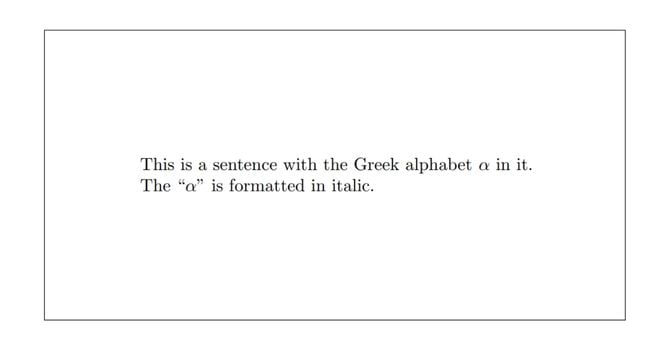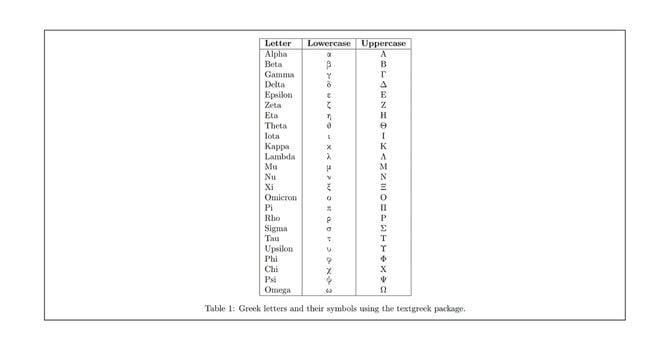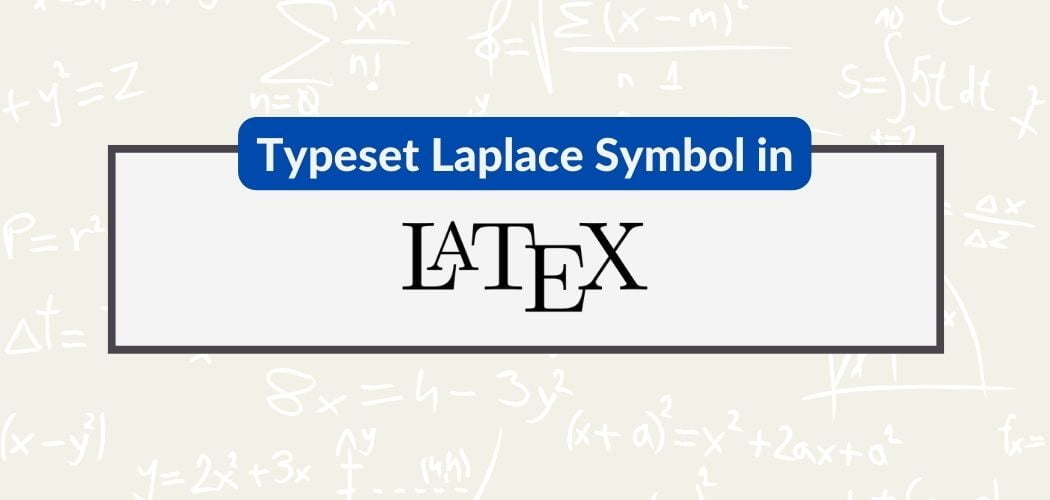Greek letters are often used to represent functions in mathematics and science. At one point, the Greek alphabet was even used for numeral systems. But in most cases, Greek letters are being used as symbols.
While our keyboard does not contain greek alphabets, we can still typeset them in LaTeX pretty easily. In this article, we’ll explore the correct way of putting any Greek alphabet in our LaTeX document — either using the built-in command or using the textgreek package.
How to typeset Greek letters in LaTeX
LaTeX provides a native way to typeset Greek letters without using any package at all. The usage is pretty straightforward and easy. To include a Greek letter in our LaTeX document, just put \ followed by the name of the Greek letter.
For example, we can use the \alpha command to generate the small case Greek letter alpha (α), the \beta command for beta (β), and the \gamma command for gamma (γ).
Note: The built-in LaTeX command uses the default math mode fonts and thus produces an italic version of the Greek letter. For example, the $\Theta$ command will generate the Greek alphabet Θ.
Using the “textgreek” package
The native and built-in command in LaTeX can be problematic in some situations because it treats Greek letters as math symbols and displays them in math mode.
For example, if we want to include Greek letters in the middle of a sentence or in a paragraph, they will be displayed in a different font and size than the surrounding text. Here’s an example:
\documentclass{article}
\begin{document}
\noindent This is a sentence with the Greek alphabet $\alpha$ in it. \\
The ``$\alpha$" is formatted in italic.
\end{document}The code above will render the following document:

As noted, the $\alpha$ command produced the italic α which is not always ideal.
This is where the textgreek package comes in. It is a specialized package that provides an easy and consistent way to display Greek letters in text mode.
The way textgreek package do it is it allows us to use the \textgreek command. This command automatically switches the font and size of the Greek letters to match the surrounding text, making it easier to include Greek letters in our LaTeX documents without causing formatting issues.
Here’s the modified version of the LaTeX code above. Notice how we’ve added \usepackage{textgreek} (Line 2) in our document’s preamble.
\documentclass{article}
\usepackage{textgreek}
\begin{document}
\noindent This is a sentence with the Greek alphabet \textalpha\ in it. \\
The \textalpha\ adapted to the surrounding font.
\end{document}
We then use the command \textalpha\ to display the Greek alphabet α upright. This is because the letter is now being displayed in text mode.
LaTeX in action
The following LaTeX code should neatly generate all the Greek letters — both in lowercase and uppercase — and display them in one table.
\documentclass[20pt]{article}
\usepackage{textgreek}
\begin{document}
\begin{table}
\centering
\begin{tabular}{|l|c|c| }
\hline
\textbf{Letter} & \textbf{Lowercase} & \textbf{Uppercase} \\
\hline
Alpha & \textalpha & \textAlpha \\
Beta & \textbeta & \textBeta \\
Gamma & \textgamma & \textGamma \\
Delta & \textdelta & \textDelta \\
Epsilon & \textepsilon & \textEpsilon \\
Zeta & \textzeta & \textZeta \\
Eta & \texteta & \textEta \\
Theta & \texttheta & \textTheta \\
Iota & \textiota & \textIota \\
Kappa & \textkappa & \textKappa \\
Lambda & \textlambda & \textLambda \\
Mu & \textmugreek & \textMu \\
Nu & \textnu & \textNu \\
Xi & \textxi & \textXi \\
Omicron & \textomikron & \textOmikron \\
Pi & \textpi & \textPi \\
Rho & \textrho & \textRho \\
Sigma & \textsigma & \textSigma \\
Tau & \texttau & \textTau \\
Upsilon & \textupsilon & \textUpsilon \\
Phi & \textphi & \textPhi \\
Chi & \textchi & \textChi \\
Psi & \textpsi & \textPsi \\
Omega & \textomega & \textOmega \\
\hline
\end{tabular}
\caption{Greek letters and their symbols using the textgreek package.}
\end{table}
\end{document}
Using the “amsmath” package
The amsmath package is a popular package for typesetting mathematical formulas and symbols in LaTeX. It provides a range of tools and commands for the formatting and layout of math-related content, including Greek letters.
With the help of the amsmath package, we can typeset Greek letters in math mode using commands such as \varphi for the letter Phi and \omega for the letter Omega. This will then allow us to include them as part of a formula or equation. Use them in conjunction with other math symbols and functions.
Summary
If we don’t use any package to typeset Greek letters in LaTeX, we can still include them in our documents using the built-in math mode commands. To include a Greek letter in math mode, we can use \ followed by the name of the Greek letter we want to include.
For example, we can use the \alpha command to generate the small case Greek letter alpha (α), the \beta command for beta (β), and the \gamma command for gamma (γ).
This may require us to remember and use the specific commands for each letter, and we may not have access to all of the formatting options and features provided by specialized packages.
Using a package like textgreek or amsmath can simplify the process of including Greek letters in our documents and provide additional formatting and layout options.
| Greek Letter | Lowercase | Built-In Command | Using “textgreek” |
|---|---|---|---|
| Alpha | α | \alpha | \textalpha |
| Beta | β | \beta | \textbeta |
| Gamma | γ | \gamma | \textgamma |
| Delta | δ | \delta | \textdelta |
| Epsilon | ε | \epsilon | \textepsilon |
| Zeta | ζ | \zeta | \textzeta |
| Eta | η | \eta | \texteta |
| Theta | θ | \theta | \texttheta |
| Iota | ι | \iota | \textiota |
| Kappa | κ | \kappa | \textkappa |
| Lambda | λ | \lambda | \textlambda |
| Mu | μ | \mu | \textmugreek |
| Nu | ν | \nu | \textnu |
| Xi | ξ | \xi | \textxi |
| Omicron | ο | o | \textomikron |
| Pi | π | \pi | \textpi |
| Rho | ρ | \rho | \textrho |
| Sigma | σ | \sigma | \textsigma |
| Tau | τ | \tau | \texttau |
| Upsilon | υ | \upsilon | \textupsilon |
| Phi | φ | \phi | \textphi |
| Chi | χ | \chi | \textchi |
| Psi | ψ | \psi | \textpsi |
| Omega | ω | \omega | \textomega |
| Greek Letter | Uppercase | Built-in Command | Using “textgreek” |
|---|---|---|---|
| Alpha | Α | A | \textAlpha |
| Beta | Β | B | \textBeta |
| Gamma | Γ | \Gamma | \textGamma |
| Delta | Δ | \Delta | \textDelta |
| Epsilon | Ε | E | \textEpsilon |
| Zeta | Ζ | Z | \textZeta |
| Eta | Η | H | \textEta |
| Theta | Θ | \Theta | \textTheta |
| Iota | Ι | I | \textIota |
| Kappa | Κ | K | \textKappa |
| Lambda | Λ | \Lambda | \textLambda |
| Mu | Μ | M | \textMu |
| Nu | Ν | N | \textNu |
| Xi | Ξ | \Xi | \textXi |
| Omicron | Ο | O | \textOmikron |
| Pi | Π | \Pi | \textPi |
| Rho | Ρ | P | \textRho |
| Sigma | Σ | \Sigma | \textSigma |
| Tau | Τ | T | \textTau |
| Upsilon | Υ | \Upsilon | \textUpsilon |
| Phi | Φ | \Phi | \textPhi |
| Chi | Χ | X | \textChi |
| Psi | Ψ | \Psi | \textPsi |
| Omega | Ω | \Omega | \textOmega |
While the two packages we explored here can be used to typeset Greek letters in LaTeX, they are designed for different purposes and have different features and capabilities. Use them to simplify the process of including Greek letters in your documents.



